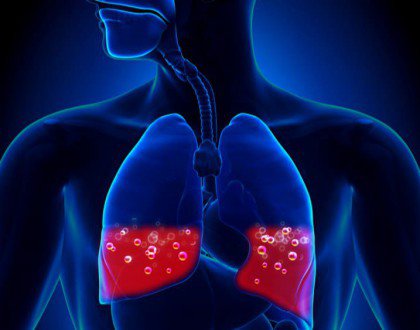Cardiogenic and Noncardiogenic Pulmonary Edema – Best 11 Difference
Cardiogenic and Noncardiogenic Pulmonary Edema
Cardiogenic and Noncardiogenic Pulmonary Edema are key for accurate diagnosis and effective treatment, both clinically and medically. The cause of pulmonary edema is conditions related to the heart, for example, left ventricular dysfunction or myocardial infarction.
It is characterized by symptoms that appear quickly and pink, frothy sputum, and crackles when auscultation is performed. Noncardiogenic pulmonary edema which is not related to heart disease typically is caused by factors such as injuries to the lungs from inhalation and an acute respiratory disorder (ARDS).
The gradual appearance, the transparent or lightly pink streaks of sputum, and the thin crackles are the main distinguishing factors. Differentiating between them is essential for the proper treatment.
The cause of cardiogenic edema is elevated pulmonary capillary pressure. Noncardiogenic edema occurs due to an increase in capillary permeability. A precise diagnosis and targeted actions are crucial for the best outcome for patients.
Importance of distinguishing between cardiogenic and noncardiogenic causes
Differentiating between noncardiogenic and cardiovascular factors that cause pulmonary edema is crucial within the realm of medicine because of the profound consequences it can have for the treatment of patients and their outcomes.
- The most appropriate choice of treatment: Cardiogenic and noncardiogenic pulmonary edemas have distinct underlying mechanisms, so they need different approaches to treatment. Treatment of cardiogenic pulmonary edema using diuretics as well as addressing issues related to the heart differs from treating noncardiogenic pulmonary swelling caused due to factors such as ARDS or injury to the inhalation. A precise diagnosis permits specific interventions to be implemented which reduce the chance in the event of wrong treatments which could cause more harm to the patient.
- Patients’ Outcomes: Quick and exact distinction between two kinds of pulmonary edema direct affects the patient’s outcomes. Implementing the right treatment in a timely manner helps relieve symptoms, enhance oxygenation, and delay the development of respiratory failure. Incorrect diagnosis or delay in treatment could cause prolonged discomfort or worsening morbidity sometimes even death.
- Resource Allocation: Medical resources, which include personnel, equipment, as well as facilities, should be allocated in a way that is optimal. A precise diagnosis can help avoid needless procedures, tests, and procedures that could result because of a misdiagnosis, or an insufficient understanding of the underlying reason.
- Preventing Complications: Each form of pulmonary edema has the potential for issues. Knowing the cause is essential for health professionals to identify and manage the associated issues efficiently and provide better treatment.
- Educational and Research: A clear distinction contributes to the quality of medical data as well as research. This also guarantees that education materials and guidelines given to doctors are current and are in line with current information in the field of medicine.
- Ethical considerations: Correct diagnosis and proper treatment are in line with the ethical guidelines to provide the highest quality medical care for patients. Patients who are misdiagnosed or treated incorrectly because of an inability to comprehend the underlying reason could result in irreparable injury.
Cardiogenic Pulmonary Edema
Cardiogenic pulmonary edema (CPE) is a medical condition characterized by the accumulation of fluid within the lungs as a result of heart-related issues, particularly those that affect the left side. This often happens because impaired pumping function leads to elevated pressure in pulmonary capillaries which allows fluid leakage into alveoli (air sacs) of the lung causing respiratory distress as well as reduced oxygen saturation levels in the bloodstream.

Common causes of cardiogenic pulmonary edema include left ventricular dysfunction (such as congestive heart failure), acute myocardial infarction (heart attack), severe valvular heart diseases, and arrhythmias. Individuals affected by cardiogenic pulmonary edema often exhibit sudden onset symptoms including shortness of breath, rapid breathing, coughing with pink foamy sputum production, and audible crackles upon chest auscultation.
Diagnosis for cardiogenic pulmonary edema typically involves clinical assessment, chest X-rays that show “batwing” patterns indicative of fluid accumulation, and echocardiography to evaluate heart function.
Immediate treatment includes providing supplemental oxygen to overcome hypoxia, diuretics to decrease fluid volume and alleviate congestion symptoms, as well as treating any underlying heart conditions that triggered cardiogenic pulmonary edema managing and optimizing them may prevent future episodes. Timely medical intervention and close monitoring and management of cardiac conditions are essential to improving patient outcomes and avoiding further complications.
Noncardiogenic Pulmonary Edema
Noncardiogenic pulmonary edema (NCE) is a condition characterized by fluid accumulation in the lungs that differs from cardiogenic pulmonary edema in that its primary cause does not lie with heart dysfunction. Instead, it usually results from factors that disrupt capillary barrier integrity or increase capillary permeability and allow fluids and proteins to leak into alveoli, impairing the exchange of oxygen and carbon dioxide between alveoli.
Common causes of noncardiogenic pulmonary edema include severe lung infections, inhaling toxic or irritating substances or substances from near-drowning incidents or drug reactions symptoms usually appear similarly to cardiogenic pulmonary edema with difficulty breathing, rapid breathing, and decreased oxygen levels they usually take effect more gradually than cardiogenic forms of the condition.

Diagnosis typically includes clinical evaluation, chest X-rays that show fluid accumulation on chest X-rays, arterial blood gas analysis to assess oxygen and carbon dioxide levels in arterial blood plasma, arterial blood gas analysis for toxic exposures or antidotes or therapies designed to counteract toxic exposures, as well as appropriate antibiotic management in case of infections.
Treatment typically aims at targeting the root cause in ARDS cases this means mechanical ventilation with supportive care or administering specific antidotes or therapies while managing infections with appropriate antibiotics. Due to a range of possible triggers, pinpointing and treating noncardiogenic pulmonary edema accurately is key for effective treatment and improved patient outcomes.
Comparison Table between Cardiogenic and Noncardiogenic Pulmonary Edema
Here’s a simplified comparison chart between Cardiogenic and Noncardiogenic Pulmonary Edema:
| Aspect | Cardiogenic Pulmonary Edema | Noncardiogenic Pulmonary Edema |
|---|---|---|
| Underlying Cause | Heart-related issues (e.g., LV dysfunction, heart attack) | Factors unrelated to heart function (e.g., infections, toxins) |
| Fluid Accumulation Mechanism | Elevated pulmonary capillary pressure | Increased capillary permeability |
| Onset of Symptoms | Rapid | Gradual |
| Sputum Appearance | Pink frothy | Clear or slightly discolored |
| Chest Auscultation | Crackles | Diffuse crackles |
| Diagnostic Focus | Echocardiography, chest X-rays | Lung ultrasound, ABG analysis, X-rays |
| Primary Treatment Approach | Diuretics, addressing heart condition | Treating underlying causes, supportive care |
| Relationship to Heart Dysfunction | Directly related to heart issues | Unrelated to heart dysfunction |
| Clinical Presentation | Severe shortness of breath, cyanosis, anxiety | Gradual onset of respiratory distress |
| Common Causes | Heart failure, myocardial infarction | ARDS, infections, toxic inhalation |
| Management Emphasis | Treating cardiac issues, fluid reduction | Addressing specific underlying causes, supportive care |
Similarities Between Cardiogenic and Noncardiogenic Pulmonary Edema
Here are a few similarities between the noncardiogenic and cardiogenic pulmonary edemas:
- A modified chest X-ray appearance: Both conditions often cause a distinctive “butterfly” or “batwing” image on chest X-rays that indicates the accumulation of fluid within the lung tissues.
- Impaired Gas Exchange: Noncardiogenic and cardiogenic respiratory edema can hinder the exchange of carbon dioxide inside the alveoli. This can lead to lower oxygen levels and possibly breathing problems.
- Auscultatory Symptoms: Crackling sounds, also known as “rales” or “crackles,” can be heard frequently during Auscultation of the chest during both kinds because of there is fluid within the lungs.
- It is imperative to intervene promptly: Prompt medical attention is essential in both instances in order to stop the deterioration of respiratory impairment as well as the possibility of progression to respiratory collapse.
- Possible Complications: Both diseases can cause serious problems when not properly managed and include organ malfunction caused by a deficiency in oxygen as well as further respiratory issues.
- Diagnostic Imaging: In both instances, chest X-rays are an essential diagnostic tool that can be used to determine the amount of the accumulation of fluid and help guide treatments.
- Clinical Description: Patients with both forms of pulmonary edema frequently display the condition of cyanosis (bluish skin color) because of poor oxygenation as well as a high rate of respiration.
The knowledge of these features shared by all can assist medical professionals in making correct diagnoses and developing suitable treatment options to treat patients suffering from pulmonary edema.
Conclusion
Distinguishing between cardiogenic and noncardiogenic pulmonary edema is key for accurate diagnosis and effective treatment, both clinically and medically. Although both share similar respiratory distress symptoms, their causes differ dramatically, and therefore treatment should also be With proper differentiation comes tailored interventions designed to prevent complications.
While improving patient outcomes making timely medical attention vitally important and reinforcing ongoing research and education efforts for optimal care of those living with these conditions.
Reference Books List
Here are some reference books that can provide more in-depth information about pulmonary edema and related topics:
- “Harrison’s Principles of Internal Medicine” edited by Dennis L. Kasper et al.
- “Pulmonary Pathophysiology: The Essentials” by John B. West.
- “ARDS: Acute Respiratory Distress Syndrome” edited by Peter J. Papadakos et al.
- “The ICU Book” by Paul L. Marino.
- “Clinical Respiratory Medicine” by Richard W. Light and Richard A. Matthay.
- “Pulmonary Physiology” by Michael G. Levitzky.


